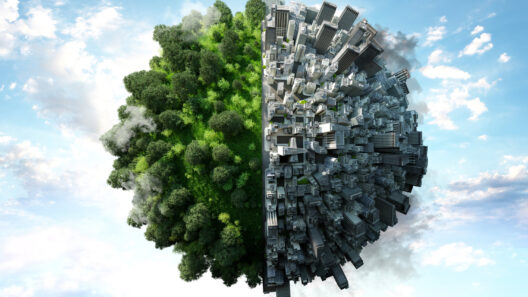In a world teetering on the brink of irrevocable change, the specter of global warming looms large, demanding immediate action. The concept of combating climate change often feels like an insurmountable mountain, with the summit shrouded in fog, complex and daunting. Yet, amidst this complexity lies a vibrant garden of potential solutions, one of which has recently started to garner substantial support—an approach that is both economical and easy to implement. This strategy embodies the essence of grassroots activism and showcases the remarkable power of communal action and individual responsibility, akin to a tapestry woven from diverse threads, each contributing to a grand vision.
The notion of reducing carbon emissions traditionally conjures images of large-scale industrial reform, solar panels stretching across sun-kissed rooftops, and wind turbines spinning in the breeze. However, a critical, and often overlooked, avenue lies in our own backyards—in the act of planting trees. Ultimately, trees serve as natural carbon sinks, effortlessly absorbing carbon dioxide from the atmosphere and releasing oxygen—a symbiotic dance that has sustained life for millennia. The beauty of this solution is not merely its effectiveness; it is the accessibility and affordability that resonates with everyone, regardless of socio-economic status.
Consider the humble sapling. For the price of a couple of cups of coffee, individuals can acquire a young tree, capable of sequestering roughly 22 kilograms of carbon dioxide per year. Imagine a community, united under the communal goal of fostering a lush landscape. Each citizen becomes not just a bystander but a proactive participant in the larger narrative of ecological redemption. Trees become symbols of hope, remarkably transforming barren lots into green sanctuaries, fostering biodiversity and rejuvenating local ecosystems—an ecological renaissance in the making.
Moreover, the psychological and social benefits of tree planting cannot be overstated. Communities that partake in afforestation initiatives often experience heightened social cohesion and improved mental health among their residents. The simple act of planting offers a profound sense of ownership and pride. It cultivates relationships between neighbors—a network of care that extends beyond individual preferences. This social dimension of tree planting is reminiscent of a shared garden, each planting contributing to the collective good, reminiscent of harmony amidst discord.
In our rapidly urbanizing landscapes, where concrete nearly suffocates the earth, trees stand as resilient sentinels. They offer respite from heat—natural air conditioners that temper extreme temperatures, reduce energy consumption, and ultimately alleviate urban heat islands. Their shade becomes a haven for families, a gathering spot for community events, and a thriving habitat for myriad species. Each tree, therefore, does not merely serve ecological functions; they also nurture social connections and community well-being.
Despite these benefits, one must confront the grim reality of deforestation—a blight that erodes our collective progress. With every tree felled, the potential for combatting climate change diminishes. Herein lies the proverbial double-edged sword: while trees offer a remedy for global warming, their destruction exacerbates the very crisis we face. Shifting public perception towards the importance of trees requires innovation—transforming the act of planting into a celebratory affair.
Embracing technology and social media can amplify the message, turning tree planting into a trend. Picture tree-planting parties equipped with live broadcasts—weaving the narrative of reforestation into the digital realm, enticing urban dwellers with compelling visuals and shared experiences. The incentives can be as diverse as the trees themselves; for every tree planted, individuals could win local business coupons, or partake in raffles that reward environmental stewardship, creating an ecosystem of mutual benefit.
Education plays a pivotal role in amplifying this endeavor. By integrating environmental studies into school curriculums, the younger generation can cultivate an early connection with their natural surroundings. Imagine classrooms transforming into nurseries—where students sow seeds, learn about ecosystems, and understand the long-term impacts of climate change. This foresight breeds a generation nurtured on stewardship—heroes in their own right, who would carry forward the torch of sustainability to confront future challenges.
While tree planting offers an alluring solution, it is essential to recognize that it is but one piece in a complex puzzle. Other initiatives, such as reducing meat consumption, supporting local agriculture, and advocating for renewable energy, must also remain integral to the broader conversation. Each strategy contributes distinct yet interconnected pathways towards achieving a sustainable future, akin to the interrelation of various hues on an artist’s palette. An effective approach embraces not only specific actions but also the ethos of collective responsibility—fostering a global movement ground in solidarity.
In contemplating the future of our planet, one cannot overlook the peculiar juxtaposition of despair and hope. The multifaceted nature of climate change may appear to eclipse efforts for remediation, casting shadows over aspirations for sustainability. However, the paradigm shift towards tree planting unravels new pathways—an undercurrent of optimism that fuels grassroots movements across the globe. The journey to combat global warming is akin to cultivating a vibrant orchard; it requires patience, nurturing, and unwavering commitment, yet bears fruits that surpass our imagination.
As the world awakens to the urgency of climate action, proponents of tree planting emerge as vital stewards of change. By uniting communities, embracing innovative outreach, and fostering intergenerational connections, the appeal of this cheap and easy solution becomes apparent. Sustainability safeguarded through collective action, each tree planted is not just a physical entity but a testament to our resolve—waving like green banners of hope in the fight against global warming. It is within these saplings that we glimpse a greener, brighter future, replete with life, resilience, and an unyielding commitment to the preservation of our planet for generations to come.






